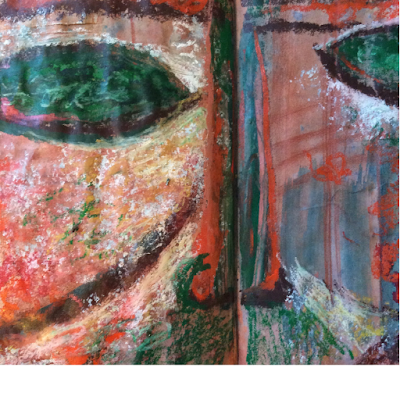Her face is a map of the world. Mapping faces
I have recently discovered the British expression 'her face is a map of the world' here. To me it means that a face takes on itself the imprint of life. Every day our face changes with us reflecting the passage of time, our experiences and feelings.
Looking at faces like maps really inspires me and I have drawn a series of sketches within the frame of my theme of masks and faces.
Tactile self portraits
'Her face is a map of the world' makes me think that we can read a face like a map. I can explore its individual marks, lines, folds and wrinkles like a territory I am exploring. And this was exactly what I had in mind while I was sketching the tactile self portraits below.
Tactile self portraits are a fascinating exercise included in one of my favourite books on drawing ever - Drawing Projects by Mick Maslen and Jack Southern.
As I told in my latest post, Sian Martin warmly recommended this book to me years ago when I started the course. Unfortunately it is not easily available now. In the tactile exercise of Project 2 you touch your face with a hand and draw what you feel with the other while keeping your eyes closed.
From my physical and digital sketchbook
It is the short circuit between touch and drawing that attracts me to this exercise and by repeating it several times and with different media the result is always new. Briefly a few examples:
- Pictures 1 and 2 are the most tactile. My preferred one is 1 because I think that the softness of the pencil suits the exercise better.
- Pictures 3 and 4 show the same sketch. For 1 I uploaded the original pencil sketch to my tablet and further developed it using the app Art Set. For drawing 2 I added strings to the pencil sketch.
It was almost impossible for me to obtain even the vaguest resemblance. Yet it is an intimate way of exploring a face that I find really satisfying.
 |
| 1 - Tactile self portrait in pencil |
 |
| 2 - Tactile self portrait in fibre pen |
 |
| 3 - Digitalized tactile self portrait |
 |
| 4 - The same sketch on paper |
Mapping a face
At this point I want to try 'mapping' a face using different approaches. For my first attempt at 'mapping' I chose a wonderful photo of Louise Bourgeois in her very old age, by photographer Alex Van Gelder.
Her amazingly expressive face, her features laboured by time and life experiences and my great admiration for her force and energy as an artist made me choose her.
But also her masterful way of staying in front of the camera and her capacity to forge herself at wish make my heart skip a beat whenever I look at her photographs. It amazes me how ambiguous her pictures are: candid and inhibited and yet also staged and deliberate. They show her complex range of faces but also her masks.
Folds and wrinkles traced
In sketch 1 above I partially retraced a black and white version of the chosen photo with a felt pen. The black lines follow her features, folds and wrinkles and are similar to the furrows and cracks of a piece of soil.
Taking the first sketch as a reference and reproducing its main lines I made collage 3 in black and white. I can still vaguely recognize a face. Yet the black network can be seen as grooves in the land or streets of a city map.
Pictures 2 and 6 are digital versions of collage 3. In 2 the 'streets' appear in low relief, while in 6 the blocks are digitally 'embossed'. On reconsidering these images and even if the contest is totally different, Alberto Burri's Cretti ('cracks') come to my mind.
Pictures 4 and 5 show paper collages from my sketchbook both based on sketch 3, with the addition of pencil, gouache and stitching.
 |
| Alberto Burri, Cretto Grande Bianco (1982) From: https://www.wikiart.org/en/alberto-burri/cretto-grande-bianco-1982 |
 |
| Cretto di Gibellina Vecchia, foto di Andrea Lodi (2008). From: https://www.flickr.com/photos/pelodia/2767707803 |








This is fascinating Daniela! I think old faces are so interesting - a map of the person's personality and experiences. I love your final abstract image.
ReplyDeleteThank you Catherine! now that you too have the book we can exchange ideas and views on the wonderful projects! 😃
ReplyDeleteCool portrait
ReplyDelete